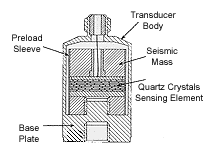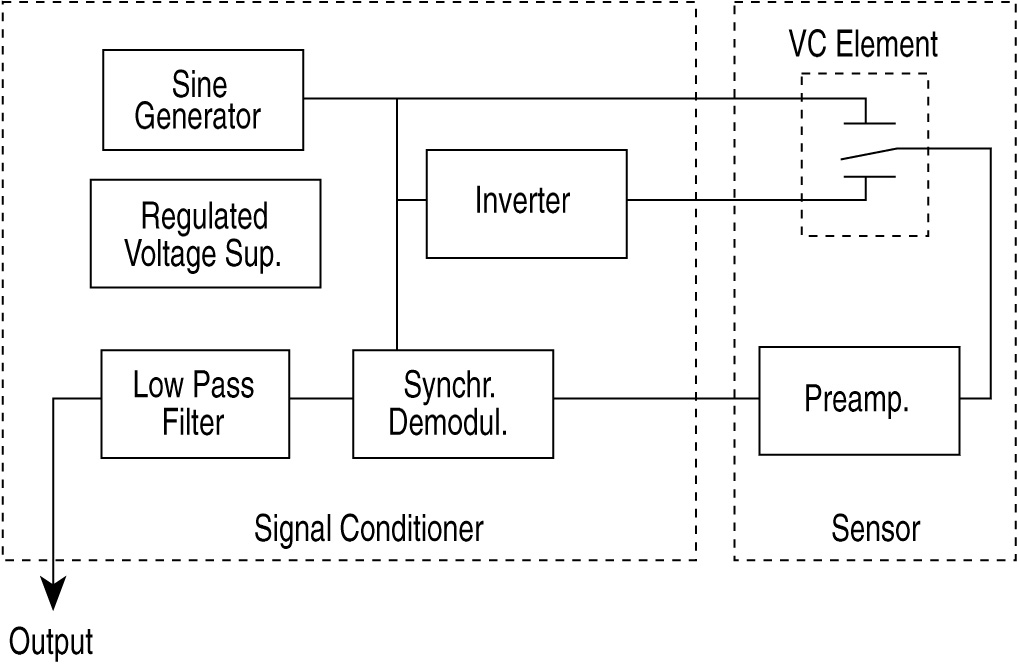
Figure 1 - Typical Compression Mode Accelerometer
Measuring Acceleration
Piezoelectric accelerometers consist essentially of three basic elements: the
transducer body, the piezoelectric sensing element and the seismic mass (see Figure 1).
The original Kistler piezoelectric accelerometers incorporated a compression design
whereby the compression cut, quartz crystal sensing element is preloaded between the base
plate and seismic mass. Because of the constant seismic mass, the force acting on the
measuring element is proportional to the acceleration in accordance with Newton's first
law: F=ma. An electrical charge is generated proportional to the force (and hence the
acceleration). Because they are basically AC coupled devices, piezoelectric accelerometers
are not suitable for measuring constant (DC) accelerations like those generated in a
centrifuge.

Figure 1 - Typical Compression Mode
Accelerometer
Although the compression cut quartz design (shown in Figure 1) is widely accepted with its inherent characteristics of long term stability, low mass, high rigidity and subsequent high resonant frequency, Kistler has introduced new accelerometers which utilize a shear mode quartz element that is sensitive to imposed shearing forces and unaffected by other orthogonal force components. In addition, the primary charge sensitivity of shear mode quartz is twice that for compression mode quartz. This results in a smaller seismic system design in shear mode units and thereby reduces their overall size and mass. As in the compression design, the force acting on the element is proportional to the acceleration in accordance with Newton's first law: F=ma and an electrical charge is generated proportional to the acceleration. Kistler accelerometers incorporating this shear quartz element are identified by the name K-SHEAR®
Kistler incorporates several other design features into their K-SHEAR units which provide combined features uncommon and superior to conventional compression designs (see Figure 2).
Conventional compression type accelerometers can be designed to be insensitive to stresses resulting from imposed base strain simply by making the base extremely large. The advantages of the shear design are realized by efficiently packaging the seismic system in a manner which isolates it from mechanically induced stresses such as base or case strain.
Conventional compression type accelerometers can be designed to be insensitive to stresses resulting from imposed base strain simply by making the base extremely large. The advantages of the shear design are realized by efficiently packaging the seismic system in a manner which isolates it from mechanically induced stresses such as base or case strain.
A construction similar to Figure 2 can be utilized since the required seismic mass is relatively small. Imposed base/case strain is isolated from the quartz and is essentially negligible at the root of the seismic support.
Output resulting from thermally induced stress is also negligible in K-SHEAR accelerometers. On compression type accelerometers, stresses caused by expansion or contraction of internal elements act directly on the preload mechanism which results in a charge output from the quartz. Similar expansion or contraction of the preload screw in K-SHEAR accelerometers results in stresses which act in an insensitive crystal direction. The optimized K-SHEAR design further reduces thermal effects by producing a nearly uniform, self-canceling thermal stress field to enter the seismic system.

Figure 2 - K-SHEAR Accelerometer
PIEZOTRON® and PICOTRON® accelerometers are low impedance types which incorporate quartz as their piezoelectric sensing element and a miniature, built-in impedance converter for the charge-to-voltage conversion. PICOTRON units are distinguished from PIEZOTRON by virtue of their very small (pico) size. PiezoBEAM® accelerometers incorporate a bimorph ceramic sensing element and a miniaturized, hybrid charge amplifier for the charge-to-voltage conversion. These units feature very high output (up to 1000 mV/g) in a very small (down to 5 grams), rugged package. Also, the Translational-Angular PiezoBEAM (TAP®) is a special purpose PiezoBEAM which simultaneously measures translational and angular accelerations.
In addition to incorporating either compressive or K-SHEAR designs, most Kistler piezoelectric accelerometers utilize built-in charge-to-voltage converters for low impedance voltage output. The low end frequency response is usually limited to 0.05 to 1 Hz, which is adequate for most shock and vibration applications. Low impedance output also allows the usage of general purpose transducer cable in environments where moisture or contamination would be detrimental to the high insulation resistance required for high impedance accelerometers. The low impedance design also provides immunity to RF/EMI.
ACCELEROMETER MOUNTING
For an accelerometer to accurately sense and generate useful data, it must be
properly coupled to the test object. This requires that the accelerometer mounting be
rigid over the frequency range of interest.
The methods for mounting an accelerometer usually depend on the accelerometer and the test structure. A selection of studs, isolated mounting pads, wax, magnets, and triaxial cubes are available from Kistler to solve virtually any mounting/installation problem. Some accelerometers have an electrically isolated mounting surface which provides electrical (ground) isolation between the transducer signal ground and the mounting surface.
Stud Mounting
The best method for mounting an accelerometer is with a threaded stud. Most
Kistler mounting studs are machined from Beryllium Copper for high strength and low
modulus of elasticity, coupled with high elastic limits. These studs provide excellent
coupling between the accelerometer's mounting surface and the test object.
Care should be taken to ensure that the two mounting surfaces mate evenly. The mounting threads must be perpendicular to the surface and free of any burrs. The surface must also be flat to ensure good coupling. Adding a slight amount of grease or oil between the mounting surfaces improves the coupling, especially at higher frequencies.
A designated mounting torque provides the proper coupling force between the accelerometer and the test object without overstressing and distorting the accelerometer mounting base. Always use the proper sockets and a torque wrench when installing accelerometers. The specified mounting torque for each Kistler accelerometer is listed on the individually supplied calibration certificates.
Adhesive Mounting
This simple method is ideal for mounting where drilling holes is not practical or where
the mounting surface is not flat.
Direct Adhesive Mounting: Many lightweight accelerometers are designed strictly for adhesive mounting. When properly mounted, these units will provide accurate data within the specified frequency range. This method is ideal for modal and structural analysis where the test structure cannot be modified for mounting the accelerometers. For measurements up to 5 kHz, wax mounting is a suitable adhesive.
Isolated Adhesive Pad Mounting: Hard anodized mounting pads offer several advantages when the accelerometer must be mounted to irregular surfaces or when ground isolation is required. These pads are adhesively mounted to the test structure providing a flat mounting surface and a high quality mounting thread. The anodized surface provides ground isolation between the transducer and the mounting surface. This is particularly useful in preventing ground loops.
Magnetic Mounting: For special applications where the accelerometer needs to be mounted to ferromagnetic structures for a quick test, one of several Kistler magnetic mounts can be used.
The accelerometer is first mounted to the magnet. These mounts can then be moved quickly to measure vibrations at several different locations. Due to the higher mass, magnets are only recommended for measurements of vibrations with frequencies up to 1000 Hz. Further, the added mass may affect the measurement of very light structures due to mass loading.
PiezoBEAM accelerometers 8628B5 and 8628B50 with the TriMOUNT® feature are an exception. These units have an integrated magnet, thus do not require an external, heavier magnet. Properly mounted, they will provide excellent data up to 2000 Hz and minimize mass loading.
Triaxial Mounting
Several triaxial mounting cubes are available from Kistler which allow mounting of up to
three individual accelerometers in orthogonal directions. The cubes' added mass and size
must be considered and may affect the overall system frequency response. Kistler also
offers integral triaxial units for those applications where mass and size profile are
critical. The optimized integral package often provides the best measurement solution.
Strain Relieving Cables
Accelerometer cables should be taped or clamped to the same surface on which the
accelerometer is mounted to avoid motion between the vibrating surface and the tiedown
point. Figure 3 below illustrates the proper techniques for routing cables with a top and
side connector accelerometer. These techniques will prevent flexing of the cable near the
connector and thereby minimize any resultant frequency response errors.


Figure 3 - Cable Strain Relief
Why K-BEAM® Accelerometers?
For low frequency, low level sensing, K-BEAM accelerometers have distinct advantages over other technologies. Ability to measure down to 0 Hz with high sensitivity and rock solid accuracy are the main features. The K-BEAM family of sensors is available in a wide variety of measuring ranges (±1g to ±50g) and mounting configurations. Output signals can be either single ended voltage, bi-polar, differential or current. Superior signal to noise ratios (>100 dB) and insensitivity to thermal effects make the K-BEAM your first choice for these types of measurements.
Principles of Operation
Kistler K-BEAM accelerometers utilize a silicon micromachined variable capacitance sensing element. This element consists of a very small inertial mass chemically etched from a single piece of silicon. The seismic mass is positioned between two plates that act as electrodes. As the mass deflects under acceleration, the change in capacitance between these plates is detected and an output signal proportional to acceleration is produced by the sensor electronics. Under very large accelerations (or shocks), the motion of the mass is limited by the two plates, thus preventing damage to the sensor. The damping of the mass by entrapped air or "squeeze film" provides an optimized frequency response over a wide temperature range. Additionally, its differential capacitive design assures immunity from thermal transients.
This expanding family of K-BEAM accelerometers includes internal or external signal conditioning, different DC voltage excitation, and diverse specifications to meet most low level to steady state acceleration measurements.

Figure 4 - K-Beam Functional Bock Diagaram
[i_include_location.htm]